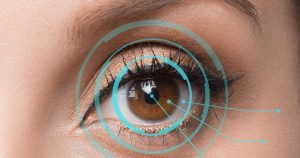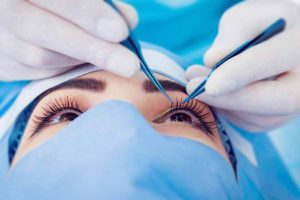Diabetic eye conditions, or diabetic eye disease, also known as diabetic retinopathy, is an eye condition that can develop in anyone who has type 1 or type 2 diabetes.
If you have diabetes, your blood sugar levels are too high. The longer this goes uncontrolled, the higher the risk of developing this eye complication. Eventually, it can cause blindness. Often, there are little to no warning signs of diabetic eye disease or vision loss when damage first develops. A full, dilated eye exam significantly helps your eye doctor to find and treat your eye problems early and oftentimes before vision loss can occur.
When’s the last time you’ve been to the eye doctor? Schedule a check-up today.
Symptoms
Most of the time, there are unfortunately no early signs of diabetic eye conditions. You may have no pain and no change in your vision as the damage begins to grow in your eyes. As the condition progresses, symptoms may include
- Floaters (spots or dark strings floating in your vision)
- Blank spots in your vision
- Pain or pressure in one or both of your eyes
- Blurred vision
- Double vision
- Total vision loss
Diabetic eye conditions often occur within both eyes. Talk with your eye doctor today if you have any of these symptoms!
Prevention
You can’t always prevent diabetic retinopathy. However, regular eye exams, control of your blood sugar and blood pressure, and early intervention for vision problems can help prevent severe vision loss.
If you have diabetes, managing your diabetes and making physical activity and a healthy diet a priority can reduce the risk of getting diabetic retinopathy. If you use tobacco, ask your doctor to help you quit. In addition, pay attention to any vision changes. If your vision becomes spotty, hazy, or blurry, call your eye doctor right away. Even though diabetes doesn’t inevitably lead to vision loss, taking initiative in your diabetes management can go a long way toward preventing complications.
How Do Doctors Treat Diabetic Eye Conditions?
Diabetes is the 7th leading cause of death in the US and is at an all-time high. In fact, according to PubMed Central, of an estimated 285 million people with diabetes worldwide, approximately one third have signs of diabetic retinopathy and of these, a further one-third is vision-threatening.
Your eye doctor may recommend having eye exams at least twice a year along with the management of your diabetes. The treatment of diabetic retinopathy can range from laser treatments, surgery, medicine, or a combination of these options. Be sure to speak with your eye doctor about the best treatment plan for you and your eyes.
Laser Treatment
Laser treatment of diabetic eye conditions targets leaking blood vessels or damaged tissue in the retina. Some lasers repair the blood vessels by directly welding and sealing leakage, other lasers eliminate the blood vessels. Lasers may also be used to destroy tissue that isn’t required for operative vision. This is done to improve blood supply to maintain eyesight.
This procedure is done to prevent vision loss or blindness.
Surgery
There are two main surgeries that help to treat diabetic retinopathy; Vitrectomy and Cataract Lens Surgery.
Vitrectomy is a type of eye operation that removes the vitreous, a jelly-like fluid inside your eye, and replaces it with a saline solution. This procedure can be done to treat problems with severe bleeding or scar tissue caused by diabetic eye conditions.
Cataract Lens Surgery can benefit those with diabetic retinopathy too. Your eye doctor can remove the cloudy lens in your eye and replace it with an artificial lens. This often results in significantly better vision afterward and the patient may require a new prescription for their glasses.
Medicine
There are various medications your doctor may treat your eyes. These medicines block the growth of abnormal blood vessels in the eye, stop fluid leaks, stop further vision loss, and even improve vision in some patients.
Your doctor may inject a medicine called anti-VEGF, or Anti-Vascular Endothelial Growth Factor Therapy. You will have several treatments during the first few months and fewer treatments after the first few rounds of therapy, and your doctor will use medicine to numb your eyes.
When To See Your Eye Doctor
As mentioned before, it’s very important to have regular checkups and comprehensive eye exams, including dilation, every year. During your eye appointment with your doctor, be sure to tell your doctor about all your symptoms. In many cases, early treatment can correct the problem or prevent it from progressing.
Even if you have seemingly perfect vision, if you haven’t been to the eye doctor in the last year, it’s time to see your eye doctor.
Diabetic Eye Conditions
Taking that trip to the eye doctor could mean early detection of eye problems, including diabetes. In fact, comprehensive eye exams can help spot early signs of high blood pressure, arthritis, and overall general health. It’s important to get regular eye exams especially if you have a history of glaucoma, macular degeneration, or corneal diseases.




